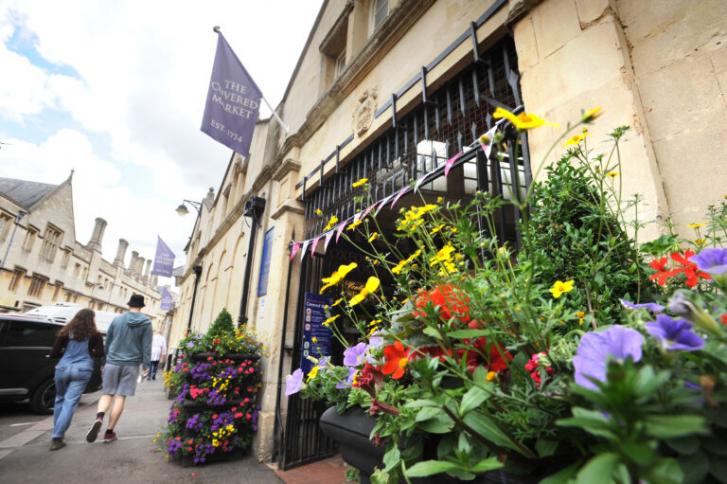
Oxford City Council has approved a £6.87m package to revitalise Oxford’s historic Covered Market.
The funding package was agreed by Cabinet at a meeting on 8 February and the project will see the entrances in High Street and Market Street transformed, larger seating areas inside, and a new dwell space outside in a new pedestrian-friendly Market Street.
The regeneration will respect the unique character, heritage and history of the Covered Market, which first opened fully in 1774, while securing the long-term future of the Grade II-listed prized council asset.
The set of proposals has come together into a 'Masterplan', prepared over a period of two years, involving extensive consultation with market traders, residents and other stakeholders.
There are three main improvements in the Masterplan:
A ‘pedestrian-friendly’ space on Market Street
This will be immediately outside the market entrances in Market Street, with the introduction of planters, seating and outdoor stalls. The public toilets are proposed to be modernised and relocated. The ‘back entrance’ to the Market will therefore be transformed into an attractive, green and accessible space to relax in the city centre.
The service yard, or loading bay for traders, will stay in its existing location, so the proposal will rely on creating a period in the day when vehicles (apart from emergency services) will not be able to access some of Market Street.
The City Council is working with traders and other Market Street stakeholders, as well as the County Council, in order to establish a practical plan that will both accommodate traders’ day-to-day business needs, while enabling the new communal space to operate.
New communal space opening onto Market Street
The Market will have a new and much more visible opening from an improved Market Street into a large, welcoming seating area, which will function as a public square during the day and a flexible event space at different times. This will bring more light into the Market and improve the entrance space.
With generous amounts of seating, it will be much easier for visitors to spend more time in the Covered Market. Sympathetic architectural changes, including the addition of glazing, are proposed to reveal and protect the building’s heritage and splendour for future generations of shoppers and traders.
Two existing units in the least historically significant part of the Market will need to be removed in order for this public square to be created, so the City Council is working with the affected businesses in order to review the opportunities to relocate within the Market.
Improved entrances on High Street and Cornmarket Street
Lighter entrances, with better signage and a new floor surface will encourage more visitors to walk through from popular shopping areas nearby. The City Council is seeking ways to improve the entrances which will benefit the Market and the High Street more generally, and is working with the adjacent landowners to action this where appropriate.
Other proposals in the Masterplan include implementing essential improvements to the services of the Market (such as drainage) at the same time as the more visible transformations already summarised. This way, the Market will be able to evolve to meet customer’s needs long into the future.
The Covered Market’s array of traders offer the widest-ever to date selection of specialist artisan produce, café’s, bars, gifts, experiences, fashion and lifestyle products.
Four exciting new businesses have recently joined this unique and much-loved community – Rozana, A Woollen Cosy Life, Soctopus and Tap Social.
In addition, in July and August 2022, the Council held a consultation on a trial of extended opening hours at Oxford’s Covered Market, which found the majority of respondents, including traders and members of the public, favour later opening hours.
Key findings:
- 70% of traders expressed an interest in extending their own hours during any pilot scheme (but would first need to consider staffing issues)
- 70% of members of the public said they would visit more often if later opening hours also involved more events and opportunities to eat and drink as well as shop
- Eating in (86%) and having a drink (73%) were cited as the most popular reason to visit
- Most popular activities suggested by the public were Trader-led events (e.g., tastings, ‘meet the trader’ talks) and music, both at 74% of those surveyed, followed by comedy (52%) and film screenings (47%)
- Responses to the extended opening hours’ consultation and the learnings from the implementation of longer opening hours will also feed into the implementation of the Masterplan proposals.
Separately, the City Council is already investing £3.1m in the Covered Market. This investment includes £1.8m on on-going work to secure the roof for another 60 to 80 years, and £1.3m for internal refurbishment and decorations.
The Covered Market project has also received £300,000 from the UK Government through the UK Shared Prosperity Fund.
The Masterplan was delivered by markets experts Gort Scott Architects, who led a multi-disciplinary team comprising Marcus Beale Architects (Heritage), Max Fordham (Environmental engineers), engineers HRW (Structural engineers), Stockdale (Quantity Surveyors), Caneparo (Transport consultants) and Transition by Design (Local engagement experts). Separate advice on the outline business case was provided by Inner Circle Consulting.
Councillor Susan Brown, Leader of Oxford City Council, said: “This is a large sum of money but it is a necessary spend in order to safeguard the future of one of the city’s most unique features. This is an investment in the city’s economy as well as one of its assets.
“We want more people to come and visit Oxford’s Covered Market and spend more time there when they do. For example, while the Covered Market is a largely accessible space, there are elements we’d still like to improve, including better lighting and removing the step into the Market from the High Street to make the Market even more accessible to people with a wide range of different and additional needs.
“Shopping habits have changed and towns and cities are changing as a result, with less pure retail and more multi-purpose destinations. Markets are making the same changes, also evolving to encourage visitors and attract a wider demographic to ensure they meet customers’ needs and expectations.
“There are a number of examples around the country of extremely successful market regeneration projects, where sympathetic changes have revitalised existing spaces and made them ‘must-see’ destinations. Learning from them and working with market traders, experts and local residents, we have built an exciting masterplan for the covered market which I look forward to seeing delivered.”




